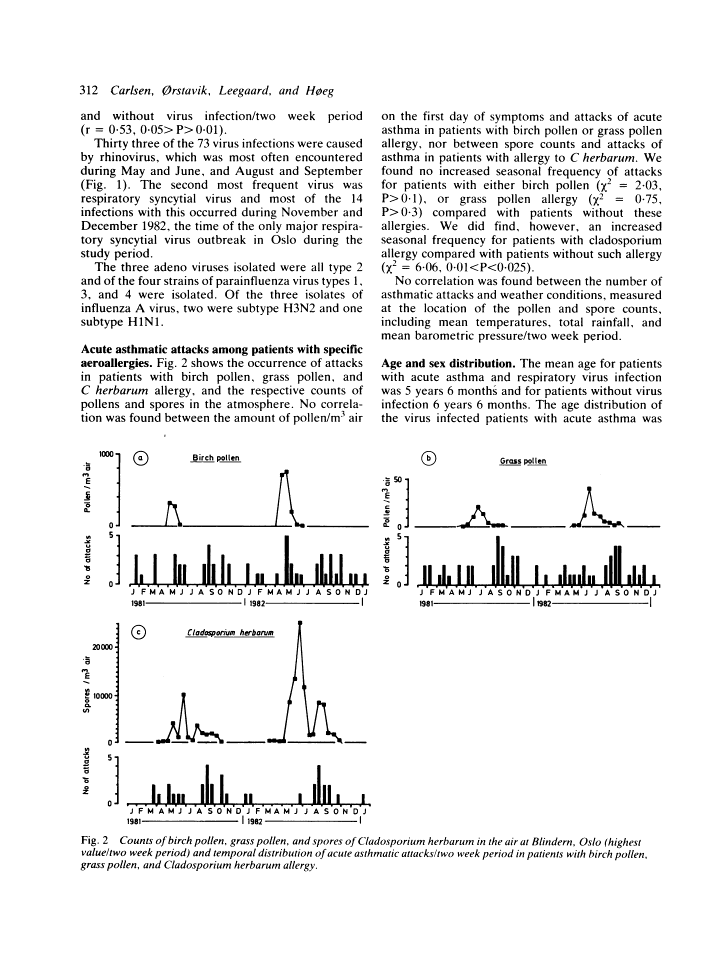Abstract
Free full text

Respiratory virus infections and aeroallergens in acute bronchial asthma.
Abstract
Two hundred and fifty six attacks of acute bronchial asthma occurring in 169 children aged over 2 years were studied during a two year period. More attacks occurred during spring and autumn than at other times of the year. In 73 patients (29%) a respiratory virus infection was diagnosed, with the same seasonal variation as the asthmatic attacks. Most of the virus infections were caused by rhinovirus (45%) and respiratory syncytial virus (19%). There was no significant correlation between asthmatic attacks in patients with birch pollen, grass pollen, or Cladosporium herbarum allergy and counts of the respective pollen or spores in the air. More seasonal attacks occurred in patients with cladosporium allergy than in patients without cladosporium allergy but there was no seasonal variation among birch or grass pollen allergic patients. Information about exposure to animals was obtained in only 12% of attacks occurring in 121 patients with allergy to animal dander. The single precipitating factor most frequently associated with acute asthma was respiratory virus infection.
Full text
Full text is available as a scanned copy of the original print version. Get a printable copy (PDF file) of the complete article (772K), or click on a page image below to browse page by page. Links to PubMed are also available for Selected References.
Selected References
These references are in PubMed. This may not be the complete list of references from this article.
- Aas K. Heterogeneity of bronchial asthma. Sub-populations--or different stages of the disease. Allergy. 1981 Jan;36(1):3–14. [Abstract] [Google Scholar]
- Larson HE, Reed SE, Tyrrell DA. Isolation of rhinoviruses and coronaviruses from 38 colds in adults. J Med Virol. 1980;5(3):221–229. [Europe PMC free article] [Abstract] [Google Scholar]
- Carlsen KH, Orstavik I. Respiratory syncytial virus infections in Oslo 1972--1978. II. Clinical and laboratory studies. Acta Paediatr Scand. 1980 Nov;69(6):723–729. [Abstract] [Google Scholar]
- Wide L, Bennich H, Johansson SG. Diagnosis of allergy by an in-vitro test for allergen antibodies. Lancet. 1967 Nov 25;2(7526):1105–1107. [Abstract] [Google Scholar]
- Johansson SG, Berglund A, Kjellman NI. Comparison of IgE values as determined by different solid phase radioimmunoassay methods. Clin Allergy. 1976 Jan;6(1):91–98. [Abstract] [Google Scholar]
- Carlsen KH, Orstavik I. Bronchopulmonary obstruction in children with respiratory virus infections. Eur J Respir Dis. 1984 Feb;65(2):92–98. [Abstract] [Google Scholar]
- Horn ME, Yealland SJ. Significance of respiratory virus isolations. A study in primary schoolchildren. Arch Dis Child. 1974 Jul;49(7):516–519. [Europe PMC free article] [Abstract] [Google Scholar]
- Isaacs D, Flowers D, Clarke JR, Valman HB, MacNaughton MR. Epidemiology of coronavirus respiratory infections. Arch Dis Child. 1983 Jul;58(7):500–503. [Europe PMC free article] [Abstract] [Google Scholar]
- McIntosh K. Bronchiolitis and asthma: possible common pathogenetic pathways. J Allergy Clin Immunol. 1976 Jun;57(6):595–604. [Europe PMC free article] [Abstract] [Google Scholar]
- Stewart DA, Moghadam H. Are antibiotic drugs needed for the treatment of upper respiratory tract infections in infants? Can Med Assoc J. 1972 Dec 9;107(11):1082–1084. [Europe PMC free article] [Abstract] [Google Scholar]
- Horn ME, Reed SE, Taylor P. Role of viruses and bacteria in acute wheezy bronchitis in childhood: a study of sputum. Arch Dis Child. 1979 Aug;54(8):587–592. [Europe PMC free article] [Abstract] [Google Scholar]
- Jenkins PF, Mullins JK, Davies BH, Williams DA. The possible role of aero-allergens in the epidemic of asthma deaths. Clin Allergy. 1981 Nov;11(6):611–620. [Abstract] [Google Scholar]
- Cockcroft DW. Mechanism of perennial allergic asthma. Lancet. 1983 Jul 30;2(8344):253–256. [Abstract] [Google Scholar]
- Welliver RC, Wong DT, Sun M, Middleton E, Jr, Vaughan RS, Ogra PL. The development of respiratory syncytial virus-specific IgE and the release of histamine in nasopharyngeal secretions after infection. N Engl J Med. 1981 Oct 8;305(15):841–846. [Abstract] [Google Scholar]
Associated Data
Articles from Archives of Disease in Childhood are provided here courtesy of BMJ Publishing Group
Full text links
Read article at publisher's site: https://doi.org/10.1136/adc.59.4.310
Read article for free, from open access legal sources, via Unpaywall:
https://adc.bmj.com/content/archdischild/59/4/310.full.pdf
Citations & impact
Impact metrics
Citations of article over time
Article citations
Presence of atopy increases the risk of asthma relapse.
Arch Dis Child, 103(4):346-351, 11 Oct 2017
Cited by: 3 articles | PMID: 29021189
Microbiology and foodborne pathogens in honey.
Crit Rev Food Sci Nutr, 57(9):1852-1862, 01 Jun 2017
Cited by: 18 articles | PMID: 26176586
Review
[Seasonality in asthma: Impact and treatments].
Presse Med, 45(11):1005-1018, 30 Mar 2016
Cited by: 2 articles | PMID: 27039335
Review
Seasonal variation of diseases in children: a 6-year prospective cohort study in a general hospital.
Eur J Pediatr, 175(4):457-464, 22 Oct 2015
Cited by: 13 articles | PMID: 26494134
Poly(inosinic-cytidylic) acid-triggered exacerbation of experimental asthma depends on IL-17A produced by NK cells.
J Immunol, 194(12):5615-5625, 13 May 2015
Cited by: 30 articles | PMID: 25972482
Go to all (69) article citations
Similar Articles
To arrive at the top five similar articles we use a word-weighted algorithm to compare words from the Title and Abstract of each citation.
Assessment of eosinophils, viruses and IgE antibody in wheezing infants and children.
Int Arch Allergy Immunol, 107(1-3):380-382, 01 May 1995
Cited by: 21 articles | PMID: 7613182
[Acute respiratory viral infections and bronchial asthma. Cellular and molecular aspects of the problem].
Zh Mikrobiol Epidemiol Immunobiol, (4):84-93, 01 Jul 2002
Cited by: 2 articles | PMID: 12449707
Review
Viruses and airborne allergens as precipitants of obstructive respiratory difficulties in children.
Ann Clin Res, 20(6):417-422, 01 Jan 1988
Cited by: 1 article | PMID: 3218914
[Acute viral respiratory infections and asthma].
Rev Prat, 46(17):2077-2082, 01 Nov 1996
Cited by: 2 articles | PMID: 8978162
Review









